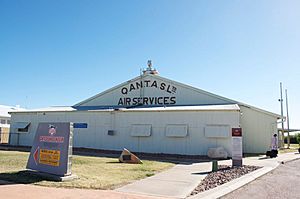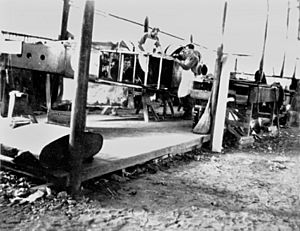Qantas Hangar, Longreach facts for kids
Quick facts for kids Qantas Hangar |
|
|---|---|

Qantas Hangar, 2011
|
|
| Location | Landsborough Highway, Longreach, Longreach Region, Queensland, Australia |
| Design period | 1919–1930s (interwar period) |
| Built | 1922–1922 |
| Official name: Qantas Museum/Former Qantas Hangar, Qantas Hangar | |
| Type | state heritage (landscape, built) |
| Designated | 21 October 1992 |
| Reference no. | 600664 |
| Significant period | 1920s-1930s (historical) 1922-ongoing (social) 1920s (fabric) |
| Significant components | views to, office/s, hangar |
| Lua error in Module:Location_map at line 420: attempt to index field 'wikibase' (a nil value). | |
The Qantas Hangar is a very old building in Longreach, Australia. It used to be a place where airplanes were kept and fixed. This hangar was built in 1922. Today, it is part of the Qantas Founders Outback Museum, where you can learn about the history of Qantas. Because it is so important to history, it was added to the Queensland Heritage Register in 1992.
Contents
The Story of the Qantas Hangar
How Longreach Grew
The town of Longreach was officially started in 1887. It became the end point of the main railway line coming from Rockhampton. Before the railway, Longreach was just a stop for people moving goods with horses. When the railway was finished in 1892, the town quickly grew bigger.
The Start of Air Travel in Australia
After World War I, people became very interested in flying. In 1919, the Australian Government offered a big prize of £10,000. This prize was for the first Australian to fly from England to Australia in less than 28 days.
Two pilots, Wilmot Hudson Fysh and Paul McGinness, wanted to try for the prize. Their engineer was Arthur Baird, who had been a flight sergeant. They had to stop their plans when the person funding them passed away. Fysh and McGinness were skilled pilots. They had won awards for their bravery during the war.
Discovering the Need for Air Services
Even though they couldn't join the race, Fysh and McGinness got a job. They were asked to map out the flight path for the race contestants. This journey took them through western Queensland and the Northern Territory. During this trip, they saw how useful an air service would be. It could connect towns in the outback that didn't have railways.
In 1920, Fysh and McGinness decided to start an air taxi service. They also wanted to offer fun "joy rides" in planes from Cloncurry. They met with a farmer named Fergus McMaster and two other supporters. These people agreed to help pay for the new company.
Qantas Takes Flight
The company was officially named Queensland and Northern Territory Aerial Services Limited, or Qantas. It was registered in November 1920. Their first official meeting was held in Winton. Arthur Baird, the engineer, joined Fysh and McGinness again. He was very important to Qantas in its early years.
In the same year, Qantas moved its main office to Longreach. This was a better central spot for their flights. Business was slow at first. Most people were only interested in joy rides. In those early days of flying, joy rides were expensive and sometimes risky.
Winning the Mail Contract
However, Qantas got support from McMaster and the new Country Party. Local councils also pushed the Australian Government. This led the government to offer a contract for flying mail. The route was from Charleville to Cloncurry. Qantas won this important contract in February 1922.
Building the First Hangar
The first Qantas office in Longreach was on Eagle Street. After a fire destroyed it, the office moved to a temporary building. Then, in May 1922, it moved to the Graziers Building. The very first hangar was built near the showgrounds in 1921.
But the mail service contract needed a bigger space. So, a new hangar was planned. A company called Stewarts and Lloyds won the contract to build it in March 1922. The new hangar was finished in August 1922. The first official mail flight happened in November of that year.
The New Aerodrome and Hangar
The new hangar was built at a new airport site. This site was about two and a half kilometers east of the town. The hangar was made with a strong tubular steel frame. It was covered with corrugated iron sheets. It measured about 36 meters long and 18 meters wide. It cost £1,637 to build.
At first, the floor was just dirt. By 1924, when the town got running water, most of the floor was covered in concrete. The older hangar near the showgrounds was taken apart. It was then rebuilt at the new airport site to be used as offices and a storage area.
Expanding Services
In the mid-1920s, the mail service was extended. It reached towns like Camooweal and Normanton. The flying service grew to do more than just carry mail. It transported food and people during floods. It also acted as an air ambulance in emergencies.
In 1926, leaders from the Commonwealth countries met in London. They encouraged the growth of air travel. This led to the Australian Prime Minister, Stanley Bruce, increasing money for civil aviation.
In the same year, Qantas started building DH50 airplanes. They built these planes under a special agreement with the de Havilland company. This work happened right inside the Longreach hangar. This practice stopped in 1929. The DH50s were replaced by more complex DH61s.
Building airplanes became a second important industry in the area. It created jobs for many local people. This new use meant the hangar needed to be bigger. Workshops were added to the sides, and sliding doors were put at the front.
Moving On
In June 1930, Qantas moved its main office to Brisbane. This meant they no longer used the Longreach hangar. They realized they needed to be bigger to survive. In 1934, Qantas joined with Imperial Airways. This merger allowed them to start international flights to England.
During World War II, the hangar was used by the Royal Australian Air Force. Later, the United States Air Force also used it. After the war, the hangar became a terminal for different airlines. These included local Longreach airline, Somerset Airways.
Changes Over Time
The biggest changes to the hangar happened in the 1960s. A passenger terminal was built at one corner. It had a waiting room, a baggage area, and offices. At the same time, parts of the roof were replaced. New supports were also added. Plans for these changes were made in 1960. The work was finished in 1963.
The signs on the ends of the hangar have been repainted many times. The signs were repainted in 1963, 1969, and 1972. In 1969, the sign on the southern end was painted over. It used to say "Qantas Empire Airlines." This name came from the 1934 merger that allowed international flights.
The hangar was used until 1996. Then, it was changed to become the Qantas Founders Outback Museum. This museum shows the history of Qantas.
What the Qantas Hangar Looks Like
The Qantas hangar is at the Longreach Airport. It is a very large building that stands alone. It is easy to see and is an important landmark in the area.
The hangar has a big open space inside, called the hangarage. It also has smaller rooms, or annexes, on its sides and at the back. The hangarage has a light frame made of tubular steel. This frame supports a gable roof with a special vent at the top. The roof is only supported by columns where it extends over the side annexes.
The ends of the hangar are covered with corrugated iron. The front (northern) end has "QANTAS LTD" painted on it. The back (southern) end says "QANTAS LTD AIR SERVICES."
At each side of the front, there are new steel frames. These frames hold the large sliding doors when they are open.
Inside, the main hangar area has a concrete floor. The floors in the smaller annexes are made of timber boards. The walls and roof of the hangar and annexes are covered in corrugated iron. Some openings are cut into the walls to let light in. There are also windows along the sides and back of the annexes. These windows are like corrugated iron flaps that open from the top. The western annexe has been changed to hold offices and facilities for the museum.
Why the Hangar is Important
The former Qantas Hangar was added to the Queensland Heritage Register in 1992. It is important for several reasons:
- Shows Queensland's History: This hangar was built in 1922. It shows how air services started in Australia. It also shows how Queensland's history developed.
- Rare and Special: It is one of the few remaining buildings from the early days of Qantas. Qantas is now one of the biggest airlines in the world. It is also one of Australia's oldest aviation sites.
- Typical Hangar Features: The hangar's large open space and side rooms show what buildings of its type are like.
- Looks Good: The hangar is a landmark in the area. Its simple design and construction also make it look good.
- Important to the Community: It has a strong connection with the people of Longreach.
- Connected to Important People: It is strongly linked to the growth of aviation in Australia. It also has a special connection with the founders of Qantas: W Hudson Fysh, Paul J McGinness, and engineer Arthur Baird.
A Queensland Icon
In 2009, during the Q150 celebrations, the Qantas Hangar was named one of the Q150 Icons of Queensland. It was recognized for its role as an important "structure and engineering feat."
Images for kids




